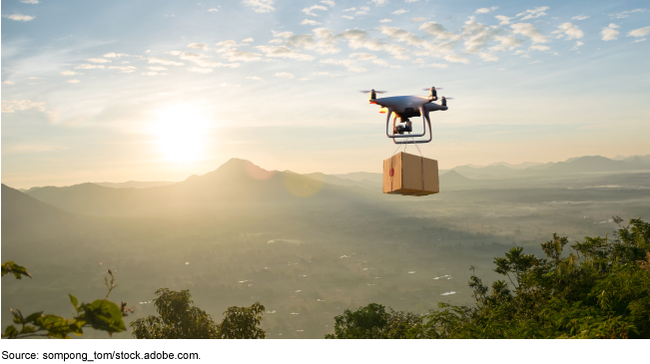Drones: Actions Needed to Better Support Remote Identification in the National Airspace
Fast Facts
The Federal Aviation Administration generally requires drones be equipped with Remote ID technology—in essence, a "digital license plate." Law enforcement can use Remote ID to investigate unauthorized drone activity.
But we found that FAA has few resources to support tribal, state, and local law enforcement in using the technology. Organizations we contacted representing these law enforcement groups told us that they hadn't received information from FAA on how they could use Remote ID.
We recommended, among other things, that FAA help tribal, state, and local law enforcement understand how to use Remote ID to help with drone investigations.

Highlights
What GAO Found
The Federal Aviation Administration (FAA) generally requires drones to be equipped with Remote ID technology, which FAA describes as a “digital license plate.” Law enforcement can use Remote ID to identify and investigate unauthorized drone activity, in line with FAA's goal for Remote ID to help law enforcement. However, GAO found that FAA has limited resources to support tribal, state, and local law enforcement on using the technology. Tribal, state, and local law enforcement agencies GAO contacted had little knowledge of Remote ID or how it could be used in their investigations. Developing such resources could help FAA better support law enforcement's ability to use Remote ID. Further, FAA is developing an interface to provide drone registration information from Remote ID to law enforcement but does not have a plan or timeline for releasing it. At the same time, the Department of Homeland Security (DHS) is developing an application for law enforcement that would link to FAA's interface, but DHS similarly does not have a plan or timeline for the effort. As a result, law enforcement may continue to experience delays with accessing real-time information needed to track and investigate unauthorized drone activity.
Examples of Drone Uses within the National Airspace System

FAA officials and stakeholders identified limitations with using current Remote ID technology to enable advanced drone operations, such as traffic management. FAA regulations call for drones to use broadcast-based Remote ID technologies, such as Wi-Fi and Bluetooth to transmit their location. However, commercial drone stakeholders told GAO that a broadcast-based signal is not sufficient for providing real-time, networked data about drone location and status as needed for advanced operations. FAA has stated it expects industry will pursue network technologies for Remote ID, such as cellular, while continuing to transmit the required broadcast-based Remote ID signal. However, stakeholders representing a commercial drone group said that there is a general lack of willingness by industry to develop network-based Remote ID alongside the required broadcast-based approach due to practical limitations, such as signal interference. FAA officials said that in the future, FAA may begin assessing what additional technology can be developed. FAA's progress toward integrating drones into the national airspace may be at risk if the agency does not assess these issues and identify a path forward.
Why GAO Did This Study
Drones are the fastest-growing segment of aviation in the U.S., according to FAA. Remote ID is intended to help FAA, law enforcement, and others locate drone operators flying in an unsafe manner or where prohibited. FAA is responsible for safely integrating drones into the national airspace and notes that Remote ID could help enable advanced drone operations.
GAO was asked to review issues related to Remote ID. This report assesses (1) potential law enforcement uses for Remote ID, and related federal support, and (2) any limitations FAA and stakeholders may face using Remote ID for advanced operations.
GAO reviewed FAA guidance and resources for Remote ID. GAO also reviewed FAA's plans for integrating drones into the national airspace. GAO interviewed FAA and DHS officials, and law enforcement and industry stakeholders that GAO identified based on their participation on FAA committees and input from other stakeholders. GAO also reviewed DHS efforts to develop a Remote ID application.
Recommendations
GAO is making three recommendations to FAA and one to DHS, including that FAA develop resources to help tribal, state, and local law enforcement use Remote ID; FAA develop a plan and timeline for a Remote ID interface; FAA identify a path forward for providing real-time, networked data about the location and status of drones; and DHS develop a plan and timeline for its Remote ID application. FAA and DHS concurred with our recommendations.
Recommendations for Executive Action
| Agency Affected | Recommendation | Status |
|---|---|---|
| Federal Aviation Administration | The Administrator of FAA should develop resources to help tribal, state, and local law enforcement use Remote ID. (Recommendation 1) |
When we confirm what actions the agency has taken in response to this recommendation, we will provide updated information.
|
| Federal Aviation Administration | The Administrator of FAA should develop a plan and timeline for deploying FAA's interface in collaboration with DHS and DOJ. (Recommendation 2) |
When we confirm what actions the agency has taken in response to this recommendation, we will provide updated information.
|
| Department of Homeland Security | The Secretary of Homeland Security should develop a plan and timeline for deploying its Remote ID app in collaboration with FAA and DOJ. (Recommendation 3) |
When we confirm what actions the agency has taken in response to this recommendation, we will provide updated information.
|
| Federal Aviation Administration | The Administrator of FAA should identify a path forward for how to provide real-time, networked data about the location and status of drones. This could include identifying and assessing short-term and long-term options and clarifying roles and responsibilities. (Recommendation 4) |
When we confirm what actions the agency has taken in response to this recommendation, we will provide updated information.
|
